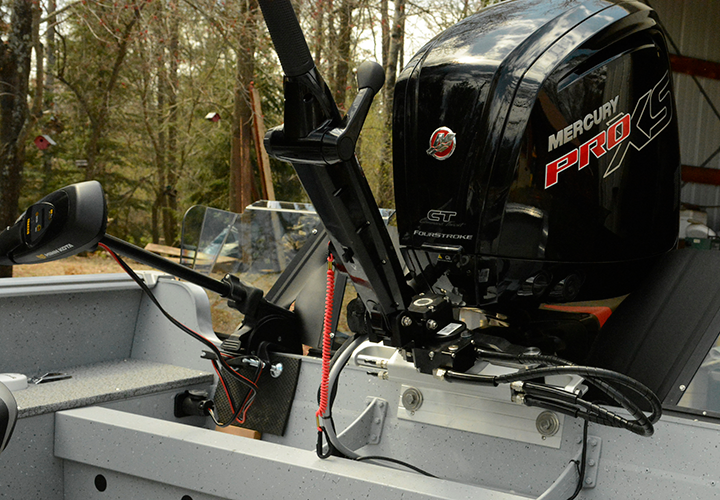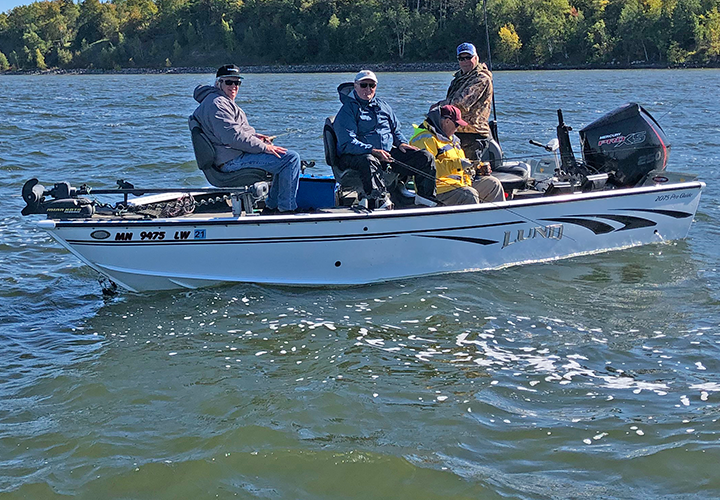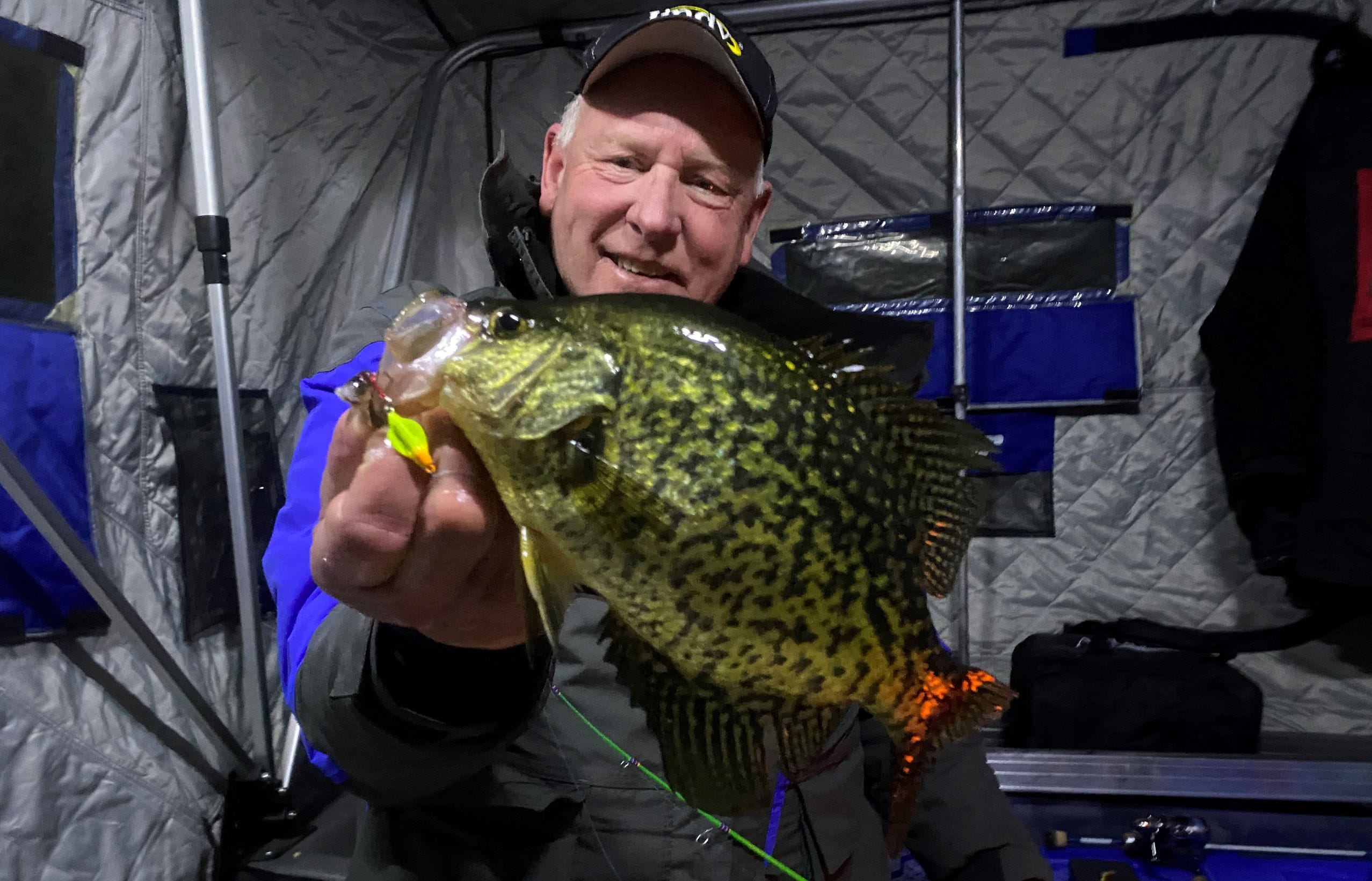
 "How Slow Can It Troll + What's So Great About Transom Mounts?" — Jeff Sundin February 6, 2023
"How Slow Can It Troll + What's So Great About Transom Mounts?" — Jeff Sundin February 6, 2023
 Last week, I published a notice about my 2022 Lund Alaskan for sale. Among the typical array of questions about the rig itself came this one, a note from Jake Murphy who asks these important questions.
Last week, I published a notice about my 2022 Lund Alaskan for sale. Among the typical array of questions about the rig itself came this one, a note from Jake Murphy who asks these important questions.
Q) What exactly does that (electric) trolling motor in the back enable you to do that the bow mount doesn’t? I was also considering a 90-horse, wondering if that would throttle down enough to troll cranks at 1.5 to 2.0 MPH. How slow can you get that 115-horsepower troll down?" Thanks, and happy fishing, Jake.
A) Jake, your questions are good ones, and they speak directly to some core fundamentals of fishing philosophy; that’s why I asked for your permission to share them with our readers. The easy one, how slow can I troll using the 115 HP Pro XS, goes first.
On the 20-foot Alaskan, in flat calm water, my 115 Pro XSs have all trolled forward at speeds well within the range of 1.5 to 2.0 MPH that you require. When trolling forward into a light chop on the water, the speeds will slow down further, into the 1.0 to 1.5 MPH range. In reverse gear, I can backtroll at .5 to .7 MPH, even slower if there’s a light chop on the water and with a whitecap slapping my stern, my crews have been able to fish vertically with the boat standing dead still, when required.
For many years, I considered the 90 Horsepower Opti Max to be the undisputed champion of slow trolling. But today, the 115 Pro XS trolls down even better than the 90 HPs did and as a bonus, pushes the boat along at faster top end speeds. For me, cruising at about 2/3 throttle allows me to travel at a comfortable 28 to 30 MPH while holding gas consumption down is ideal. But when faster speeds might be called for, the 115 HP allows 42 to 44 MPH with modest loads. When the boat is packed full of people and gear, 39 to 40 is more realistic, in my experience.
Admittedly, answers to your question regarding transom mount vs bow mount electric trolling motors are somewhat subjective but are important and should never be glossed over.
The first thing I’d do, if it was up to me, would be to drop the term “trolling motor” because trolling, while it can be accomplished with this piece of equipment, is NOT it’s most important function. This tool, when properly used, allows the coxswain to precisely slip along a breakline, weed bed or other structure. The anglers on board enjoy the benefit of having their lures placed directly over or near fish, or the structures the fish are relating to. So, a clever marketing staff might come up with a new name like “precision angling presentation placement system” or something along those lines.
For the first 30 years of my guiding career, I would have told you that the only electric you need is a transom mount. In fact, I never had a bow mount electric on any of my boats between 1990 and 2016; 26 years with nothing but a tiller handle. But the advent of a bow mounted electric motor capable of communicating with GPS positions changed that. Technology allowing me to “spot-lock” at a fixed position while casting toward, or fishing vertically over a school of fish made the bow mount too useful to pass up. I wrote about that in a report May 2019, Bow Mount Trolling Motor On Tiller Boat, Why? about how the ability to hold fixed positions with precision turned the bow mount into a necessity, rather than a luxury. As nice as the bow mount electric is, there are days when I could not do my job without a transom mount.
Keeping the lines of a boatful of anglers away from the stern of the boat is the most tangible example I can offer. Anglers, especially inexperienced ones, don’t always pay attention to the relationship between the boat and where their lures and lines are located. “Trolling” forward in a straight line forces their presentations back and under the transom. The danger there is that transducers, mounting hardware and outboard engines offer great opportunity for tangled lines and snagged lures.
 The cure for all that tangling is to drift the boat, rather than troll with it. The image at right of my friend Jeff Skelly illustrates the point. He's using his transmom mount to hold position during a drift, so his customers can fish free and clear.
The cure for all that tangling is to drift the boat, rather than troll with it. The image at right of my friend Jeff Skelly illustrates the point. He's using his transmom mount to hold position during a drift, so his customers can fish free and clear.
With the transom mount turned at a 45-degree angle to the wind, the boat is allowed to drift, or slip along structure. The result is placing the anglers lines either perpendicular to, or in front of the boat. In those regions, their lines and lures are running in clear territory, safe from the most common “tangle magnets”. When needed, a drift sock enhances the guide’s ability to control boat and speed even more. The scene is a common one, and when fishing in my region, you’re likely to see most, if not all the better fishing guides using this approach.
Another advantage that the transom mount electric offers is steering precision. On most boats, transducers for the main electronics are located at the transom. As the boat operator turns the bow mount in response to changes in water depth, or attempts to follow contour line on the chart, the transom moves in the opposite direction. It takes some time for the electronics to reflect the change in steering direction. This often results in the operator over-shotting the target, forcing a turn back in the other direction. This creates a cycle of over-shooting, then over-compensation that’s hard to break. When you see a boat trolling in an erratic “S-Curve” pattern, this is often why it’s happening.
When you realize that the transducer is the pivot point for steering it makes sense to have your steering mechanism, whatever it is, located directly alongside the transducer. Now as the boat operator turns the transom mount in response to changing depths or to follow a chart, the changes are reflected almost immediately on the electronics. The result is more accurate steering for the captain, and more time over the target for the crew. When you want to see your guests catch fish, this gain in efficiency makes a huge difference.
Less tangible, but no less important is a transom mount motor’s ability to work with the wind instead of against it. Using a bow mount in calm to medium wind speeds is fine, even delightful at times. But when the bow is plowing into the whitecaps and the prop is popping in and out of the water, the fun goes away fast, especially for the crew who are seated toward the front.
Now I’m not saying that its fun, or friendly, but when the whitecaps are crashing into the stern, I can still hold the boat so that my crew can fish. More than a few times every summer, somebody turns toward me and comments about “my” ability to keep them over fish in rough conditions. In truth, it has nothing to do with “my” ability at all, it’s just that I happen to have the right tools to use when they’re needed.
 River current offers plenty of opportunity for transmom mount electrics too. I demonstrate that in a 2010 video filmed up on the Rainy River, click the image at left to view it.
River current offers plenty of opportunity for transmom mount electrics too. I demonstrate that in a 2010 video filmed up on the Rainy River, click the image at left to view it.
Summing it up Jake, there are anglers who won’t see any need to be prepared for every eventuality by having both a bow mount and transom mount electrics.
For me though, this is a question of philosophy. I know for sure that there will be a certain number of days every summer when I can’t do my job unless I’m prepared for any eventuality. If I wan't to offer my customers the best possible chance of catching fish on every outing, I will always need to have electric motors on both bow and stern.
I'll close by offering free guidance for folks who haven’t experienced fishing with a properly rigged transom mount electric. They offer a level of freedom that can’t always be explained, but definitely can be experienced. That's why I would highly recommend at least trying one, get with a friend who has one or setup a test drive. At the very least, re-visit more of the old fishing shows and articles, transmom mount electrics may be out of fashion at the moment, but rest assured, they have been at the heart of many a great fishing career. ![]() — Jeff Sundin 218-245-9858 or EMAIL
— Jeff Sundin 218-245-9858 or EMAIL
More Recent Fishing Reports
Ely MN 02-01 • Lake of the Woods 02-01 • MN-Fish DNR News 1-26 • Grand Rapids MN 1-25 • Green Weeds During Winter? 1-24 • Grand Rapids Area 1-23 • Panfish Selective Harvest 1-19 • Follow on Facebook
 "Ice Fishing Gear: Selecting Rods, Reels and Line" — January 11, 2023
"Ice Fishing Gear: Selecting Rods, Reels and Line" — January 11, 2023
 Lurenet Pro Tips Article: "Whether at a fishing show or on the ice or through his popular daily fishing reports, Jeff Sundin commonly gets asked about the gear he uses for ice fishing. We’re excited to be able to share his answer to that question.
Lurenet Pro Tips Article: "Whether at a fishing show or on the ice or through his popular daily fishing reports, Jeff Sundin commonly gets asked about the gear he uses for ice fishing. We’re excited to be able to share his answer to that question.
Anglers sometimes ask about the rods, reels and lines I use for ice fishing. Like with any tool, the trick is to correctly match fishing rods and reels with the task that they’ll be required to perform. Having the “latest and greatest” (typical translation: most expensive) gear isn’t always the best solution.
High-end, specialized gear can offer certain tactical advantages, but sometimes there are trade-offs that ..." Learn More >> Select The Best Ice Rods, Reels and Lures January 11, 2023
Jeff Sundin is a full time fishing guide, outdoor writer and photographer. Learn about guided fishing trips and more, click >> More About Jeff Sundin.
Current Fishing Reports • Guided Fishing Trips • Current Video • Fishing Articles • Fishing Links • Contact
The Fishrapper, Fishing Blue Books, LLC • 715 Byington Ave • La Prairie, MN 55744 • 218-245-9858
copyright©2023 Fishing Blue Books, LLC All Rights Reserved - last revised 07/16/2023